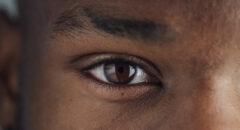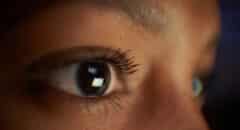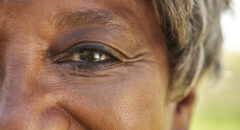
With the prevalence of digital screens in nearly every aspect of life—from education to entertainment—it’s more crucial than ever to ensure that your child has their eye health monitored regularly. BlackDoctor.org spoke with optometrist Jen Wademan to discuss the vital importance of regular eye exams for children and what parents should know about protecting their children’s eyes.
The Critical Role of Vision in Learning
Vision plays a foundational role in a child’s ability to learn.
“As parents, our primary goal is to set our kids up for success, and one area parents often overlook is vision. We want to ensure our kids are seeing clearly and comfortably in the classroom to set them up for success both inside and outside of the classroom,” Dr. Wademan shares.
Although school-based vision screenings are a great way to start, they don’t replace a thorough eye exam.
“During an eye exam, we’re not just looking at whether a child is seeing clearly; we’re also assessing how their eyes are working together. These skills are crucial, especially in the classroom, where children are frequently shifting focus from the whiteboard to their papers. We want to make sure they aren’t skipping lines while reading, which could indicate an underlying eye issue,” Dr. Wademan advises.
Common Eye Health Issues in Children
When discussing common eye health issues, Dr. Wademan notes that children often avoid certain activities—like reading—due to undetected vision problems. The goal of comprehensive exams is to identify these issues early on.
“If we find that kids are avoiding certain activities like reading, it may be due to visual issues or problems with how their eyes work together. We’re also checking the overall health of a child’s eyes to ensure everything looks healthy. If not, we can take proactive and preventative measures to address any issues,” Dr. Wademan adds.
Comprehensive eye exams are also important if your child spends a lot of time on digital devices.
The Impact of Screen Time on Children’s Vision
In a recent ZEISS Vision Care study, 82 percent of parents expressed concern about how digital screens are impacting their children’s vision. More than half reported that their child spends at least three hours a day on a screen.
“I can relate to that as a parent; my kids use screens in the classroom, and it’s pretty common at home with tablets and cell phones,” Dr. Wademan shares. “Our biggest concern, on a larger scale, is the increase in nearsightedness we’re seeing in children, which stems from the increased amount of “near work” they’re doing, and screens are definitely a culprit. On a smaller scale, we’re seeing issues like dry eyes, headaches, eye strain, and difficulty focusing.”
Since screens have become an almost unavoidable part of daily life, both in the classroom and at home, Dr. Wademan recommends that parents balance screen time by promoting outdoor activities, limiting device use after school, and ensuring regular breaks to reduce eye strain.
“Devices are such a big part of our children’s lives now. So it’s essential to be mindful of the amount of time spent on screens and to recognize that there’s already a lot of screen time in the classroom. Limiting screen time after school is vital. Encouraging kids to unplug, spend time outside, go for walks, take breaks, and engage in activities that involve more distance vision can be beneficial. Getting them involved in sports or after-school activities is also helpful,” she shares.
Smart Solutions for Protecting Children’s Eyes
It is also important to note that children’s eye care needs differ greatly from adults. From pupil size to the way they interact with digital devices, children’s vision requires special attention.
If your child needs glasses, consider lenses like the ZEISS SmartLife Young lenses, which are designed to address the specific needs of children. Unlike traditional lenses, which are primarily made for adults, these lenses are tailored to suit children’s unique anatomy, including their smaller facial features and habit of holding devices closer to their eyes. Furthermore, they provide crucial blue light and UV protection, which is important for children who spend a lot of time both indoors on screens and outdoors in the sun.
“We have specific eye care products and solutions tailored to kids, and the Zeiss SmartLife Young lenses are designed specifically for children who need vision correction,” Dr. Wademan notes. “I often discuss this with adults, as we have various products specifically designed for our needs, whether it’s something for computer use or otherwise. It’s all about optimal clarity and comfort. We can’t forget our kids need the same, especially considering how they’re using their eyes at school and outside of it.”
RELATED: Back to School: How Much Screen Time Is Too Much?
Encouraging Healthy Eye Habits at Home
Dr. Wademan also stresses the importance of building healthy eye habits early in life.
In addition to finding the appropriate balance between screen time and other activities, sun protection is also key, especially since children tend to spend more time outdoors than adults. Sunglasses with proper UV protection should be a part of every child’s daily routine.
Furthermore, a child not complaining about their vision doesn’t necessarily mean there isn’t a problem.
“Not all children can articulate that they aren’t seeing as well as they should be. As parents, it can be hard to tell unless a child is squinting, or a teacher reports that they think a child is having trouble seeing. Other symptoms, like headaches, eye strain, or excessive rubbing of the eyes, or a child avoiding tasks like reading, can also be signs of an underlying eye issue,” Dr. Wademan notes.
You may also notice your child tilt or turn their head in a particular way to see clearly or to avoid double vision.
“Kids are very adaptable and often compensate for vision problems without knowing they should be seeing better,” Dr. Wademan adds.
The Future of Children’s Eye Care
As technology continues to advance, so does our understanding of eye health. Dr. Wademan is optimistic about the future, noting that companies like ZEISS are constantly improving and creating tailored solutions for children’s unique visual needs.
With the right care, children can thrive both in the classroom and in life, setting a foundation for long-term visual well-being. As a parent, it is important to stay proactive and make eye health a priority as part of your child’s routine checkups.
“Many people may not know this, but we can see a child as early as six months of age. I often tell parents that if there’s a strong family history of eye conditions or if they notice something with their baby or young child, it’s a good idea to bring them in. The six-to twelve-month range is a good first step. After that, the next recommended eye exam is between ages three to five, especially before starting school,” Dr. Wademan advises.”Then, after that, it’s recommended to have an eye exam every year.”
Visit Zeiss.com to explore product options for children, find resources on eye exams, and learn more about the new SmartLife Young lenses.









